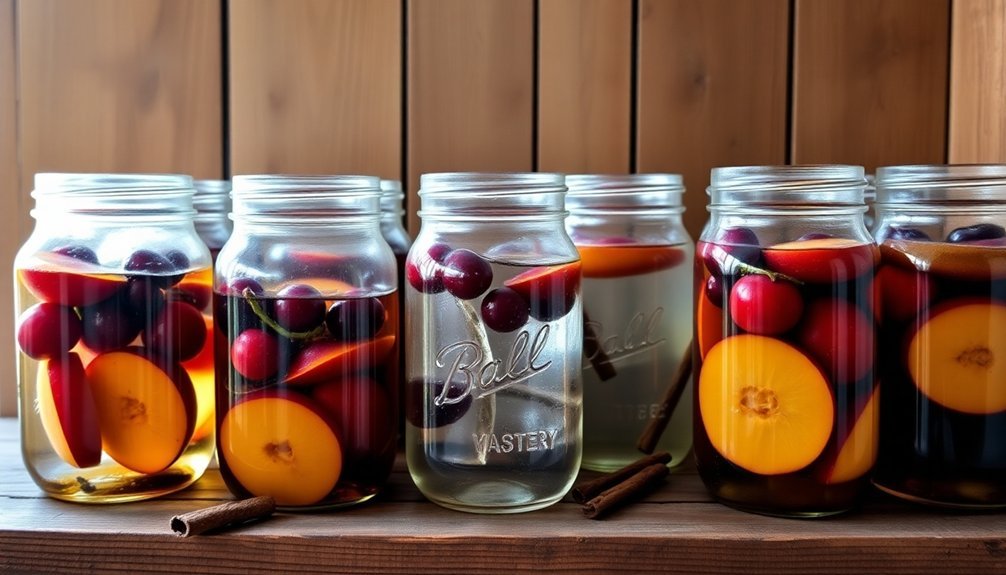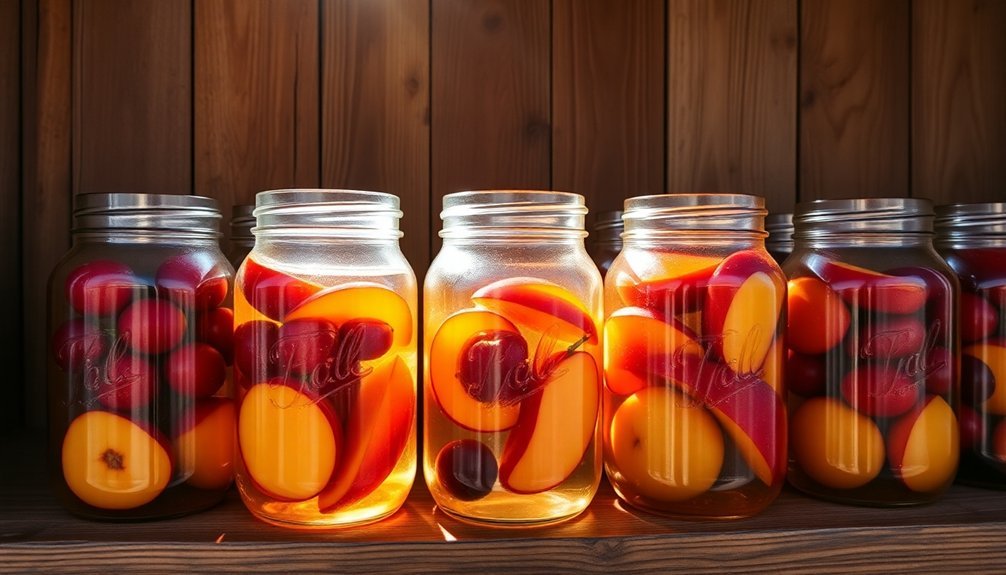You can preserve food using three time-tested alcohol methods that enhance flavor while extending shelf life. First, pickle vegetables by combining vinegar brining with spirits, creating unique taste profiles that last up to a year. Second, preserve fruits in wine by layering them with sugar, allowing the mixture to develop complex flavors over three months. Third, use traditional fermentation techniques with alcohol to create preserved foods that can last up to two years while boosting nutritional value. These preservation methods offer just the beginning of what you'll discover about alcohol's remarkable food-saving capabilities.
Pickling With Spirits

Pickling with spirits offers a unique twist on traditional preservation methods, combining the time-tested practice of vinegar brining with the bold flavors of alcohol.
You'll need to start by preparing your cucumbers properly, cutting thin slices from the ends to prevent mushiness and washing them thoroughly. Pack them tightly into clean jars along with fresh dill, garlic, and your chosen spices.
To create your spirit-infused pickles, you've got two main approaches. You can either add the spirits directly to the jars before pouring in your hot brine, or mix them into the cooled brine solution. If you're using beer, it's best to add it to the cooled vinegar mixture to preserve the alcohol content. Many makers prefer using 40 proof vodka for its neutral flavor profile and reliable preservation properties.
The typical brine ratio ranges from 70:30 to 50:50 water-to-vinegar.
You'll want to store your spirit-pickled foods in the refrigerator to maintain their quality. The combination of vinegar's acidity and alcohol helps prevent microbial growth, extending shelf life up to a year when properly stored.
Remember to seal your jars tightly and give them a gentle shake to guarantee the spirit is evenly distributed throughout the pickles.
Fruit in Wine
While pickled vegetables preserve garden bounty, wine-soaked fruits offer a more luxurious approach to food preservation. You'll want to select slightly under-ripe fruits that won't fall apart during the preservation process, particularly when working with stone fruits. This method produces both preserved fruit and flavored wine as delightful outcomes.
Make certain you're using clean glass jars, preferably pint-sized canning jars, to guarantee proper storage.
Layer your fruit with sugar and wine, making sure the fruit stays completely submerged. You can adjust the sugar content based on the fruit's natural sweetness and your personal preference. If you'd like to add complexity, consider incorporating spices, though they're not essential to the preservation process.
You'll need to gently shake the jars every few days to help dissolve the sugar and distribute the flavors evenly. Store your jars in a dark cupboard for 3-4 weeks before transferring them to the refrigerator.
Once refrigerated, they'll keep for up to three months, but you should use them within two weeks after opening. The preserved fruit works wonderfully in desserts, while the infused wine can enhance your favorite cocktails or cooking recipes.
Fermented Food Preservation

Every civilization has developed unique fermentation techniques to preserve food, and these methods remain relevant today. You'll find four main types of fermentation that effectively preserve food: lactic acid, alcohol, acetic acid, and mold fermentation. Each creates distinct flavors while preventing spoilage through different mechanisms.
When you're planning to ferment foods, you'll need to follow key protocols for success. Start by sterilizing all your equipment to prevent harmful bacteria from contaminating your ferment. Lactobacillus bacteria are essential for successful fermentation.
For vegetable preservation, you'll want to create a proper salt brine – typically using 3 tablespoons of salt per quart of water. If you're planning cold storage, you can reduce the salt by half.
You'll need to pack your vegetables tightly and keep them submerged using weights or large cabbage leaves. This creates an anaerobic environment essential for proper fermentation.
Once fermentation is complete, top off your jar with clean water and seal it. When stored in cool conditions below 50°F, your fermented foods can last one to two years.
These preservation methods don't just extend shelf life – they'll also enhance your food's nutritional value and digestibility.
Frequently Asked Questions
Can Alcohol-Preserved Foods Be Safely Consumed by Children?
You shouldn't serve alcohol-preserved foods to children, as they're more sensitive to alcohol's effects. Even small amounts can be harmful to their developing systems, and cooking doesn't completely eliminate the alcohol content.
How Long Can Homemade Alcohol-Preserved Foods Last at Room Temperature?
You'll find that properly prepared alcohol-preserved foods can last 6-12 months at room temperature. Keep them in sealed containers away from heat and sunlight, and always monitor for any signs of spoilage.
Does Cooking With Alcohol-Preserved Ingredients Remove All the Alcohol Content?
No, you won't eliminate all alcohol when cooking with alcohol-preserved ingredients. Even after 2.5 hours of cooking, about 5% of the alcohol remains. The cooking time and method determine how much alcohol is retained.
What Percentage of Alcohol Is Ideal for Home Preservation Methods?
You'll need 14-20% alcohol concentration for most home food preservation methods. For best results, combine it with other preservatives like vinegar or salt to guarantee safe, effective preservation of your ingredients.
Can I Reuse the Preserving Alcohol for Multiple Batches of Food?
You shouldn't reuse preserving alcohol due to contamination risks and reduced effectiveness. Each batch needs fresh alcohol to guarantee proper preservation. If you reuse it, you'll compromise food safety and quality.
In Summary
You've now discovered three reliable methods for preserving food with alcohol. Whether you're pickling vegetables in spirits, soaking fruits in wine, or using fermentation techniques, these time-tested approaches will help you extend your food's shelf life while adding unique flavors. Give these methods a try in your kitchen – they'll transform your preservation game and expand your culinary possibilities.





Leave a Reply